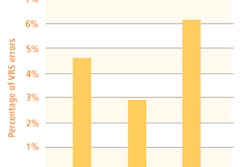For frail elderly patients, a visit to a hospital radiology department for an imaging examination can be an exhausting, disorienting ordeal. Physicians in Torino, Italy, reported in the Archives of Internal Medicine that home delivery of radiology services can eliminate this problem.
Physicians from the geriatric and radiology departments of the University of Torino reported in a research letter dated 8 August 2011 that a pilot study to determine the feasibility of performing exams using lightweight portable x-ray equipment proved to be beneficial for patients, and that image quality was indistinguishable from exams performed in a radiology department.
The RAD-HOME project enrolled 69 patients who received treatment from the Hospital at Home Service of San Giovanni Battista Hospital in Torino. Patients who needed to have chest radiographs performed between June 2008 and June 2009 were randomly assigned to either having the exam performed at the hospital's radiology department or at their place of residence.
The patients had a mean age of 78 years, were acutely ill, immobilized or chair-bound, and had a high risk of delirium. Most radiographs were ordered for patients with pneumonia, symptoms of exacerbated congestive heart failure, or exacerbated chronic obstructive pulmonary disease (COPD). Patients were assessed before and after the radiology exam to determine if they showed any symptoms of delirium. If they did, the Delirium Rating Scale was completed for these patients by a medical staff member, according to Dr. Nicoletta Aimonino Ricauda of the university's department of medical and surgical disciplines -- geriatric section.
Radiographers who imaged the "at-home" group of patients positioned the portable CR x-ray unit (Computed Radiography POC 260, Carestream Health) to prevent persons from entering the controlled area where the x-ray exam was being performed. They wore protective clothing if necessary. Equipment was transported in a van, which contained a PACS acquisition workstation that transmitted the images via the Internet to the radiology department. The exams were promptly reported by radiologists working in the department at the time.
The control group had chest x-ray exams performed in the emergency department. These went into a queue in the PACS as well for immediate interpretation. Radiologists who read the studies of both groups were blinded to the origin of the exams.
Six patients who had a hospital-based exam experienced delirium several hours to one day following the procedure, and required treatment for their acute confusional state. However, none of the patients who had the exam performed in familiar surroundings experienced delirium. In fact, some expressed satisfaction that the exam was performed where they lived.
Seven radiologists blinded to the location of the exam independently assessed the quality of all the images. They rated the home-based exam images as good or excellent for 94% of the patients.
While the number of participants in the RAD-HOME project was quite limited, and the authors recommended that additional studies be performed with larger numbers of enrolled patients, they suggested that providing home delivery of radiography services might contribute to reducing the incidence of iatrogenic illness of frail, easily confusable, elderly adult patients.


















